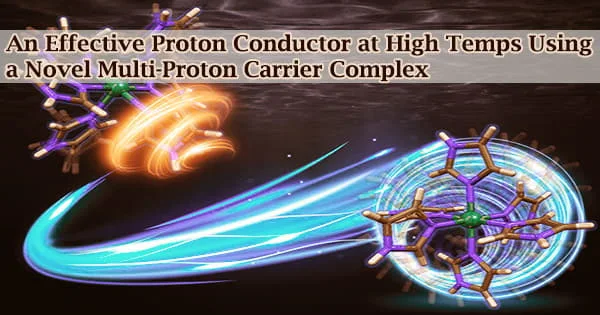For effective high-temperature proton conduction in fuel cells, researchers create a ruthenium (III) complex with six imidazole-imidazolate groups that is very symmetric. Because they rely on water as a proton conduction medium, fuel cells frequently struggle to operate at temperatures above 100 °C.
To address this problem, a group of Japanese scientists created a brand-new hydrogen-bonded starburst-shaped metal complex made up of six imidazole-imidazolate groups and the ruthenium (III) ion. Even at 180 °C and -70 °C, the final single molecule crystal exhibits good proton conductivity.
Fuel cells are getting a lot of interest as people turn to more sustainable and environmentally friendly energy sources. The key benefit of using fuel cells is that they can produce energy using only water as a byproduct while using the clean fuel hydrogen.
The usual lithium-ion batteries that currently power all contemporary electronic devices could be replaced by this new, eco-friendly source of electricity. The Nafion membrane, an ionic membrane made of synthetic polymers, is what most fuel cells use as their solid electrolyte and water-based proton conductor.
However, the use of water as a proton conduction medium has a significant disadvantage for the fuel cell in that it is unable to operate correctly at temperatures above 100 °C, the point at which water begins to boil, which results in a decrease in proton conductivity. New proton conductors are therefore required, ones that can transfer protons effectively even at such high temperatures.
A team of Japanese researchers has announced a novel imidazole-imidazolate metal complex-based high-temperature proton conductor that exhibits excellent proton conductivity even at 147°C. The team was directed by Prof. Makoto Tadokoro from the Tokyo University of Science (TUS).
The research team included Dr. Fumiya Kobayashi from TUS, Dr. Tomoyuki Akutagawa and Dr. Norihisa Hoshino from Tohoku University, Dr. Hajime Kamebuchi from Nihon University, Dr. Motohiro Mizuno from Kanazawa University, and Dr. Jun Miyazaki from Tokyo Denki University.
Fuel cells hold the key to a cleaner and greener tomorrow. Our study offers a roadmap for improving the performance of these carbon-neutral energy resources at high temperatures by designing and implementing molecular proton conductors that can transfer protons efficiently at such temperatures.
Professor Makoto Tadokoro
“Imidazole, a nitrogen-containing organic compound, has gained popularity as an alternative proton conductor for its ability to operate even without water. However, it has a lower proton transfer rate than conventionally used Nafion and melts at 120°C. To overcome these issues, we introduced six imidazole moieties into ruthenium (III) ion to design a new metal complex that operates as a multi-proton carrier and has high-temperature stability,” explains Prof. Tadokoro when asked about the rationale behind their study, which was published online first on June 27, 2022, in Chemistry A European Journal and featured on the front cover of the journal.
The researchers created a novel molecule with core ruthenium (III) ion (Ru3+) and three imidazole (HIm) and three imidazolate (Im-) groups attached. The resulting single molecule crystal had a “starburst” form and was very symmetrical.
Each of the six imidazole groups connected to the Ru3+ ion functions as a proton transmitter, the scientists discovered after examining the proton conductivity of this starburst-type metal complex. Because HIm molecules could only carry one proton at a time, this made the molecule 6 times more powerful.
The scientists also looked at the mechanism underlying the starburst molecules’ capacity for high-temperature proton conduction. The researchers discovered that the proton conductivity at temperatures greater than -70 °C was caused by distinct localized rotations of the HIm and Im- groups and proton jumps to other Ru(III) complexes in the crystal via hydrogen bonds.
The better proton conductivity at high temperatures, however, was also caused by whole-molecule rotation, which occurred at temperatures above 147°C.
The scientists used “solid-state 2H-NMR spectroscopy” to validate the rotation, which led to a conductivity rate that was three orders of magnitude higher ( σ = 3.08 10-5 S/cm) than that of individual HIm molecules ( σ = 10-8 S/cm).
According to the research team, solid-state electrolytes that conduct protons may adopt a new guiding principle as a result of their findings. Their inventive molecular design has provided insights that could be exploited to create new high-temperature proton conductors and enhance the performance of already existing ones.
“Fuel cells hold the key to a cleaner and greener tomorrow. Our study offers a roadmap for improving the performance of these carbon-neutral energy resources at high temperatures by designing and implementing molecular proton conductors that can transfer protons efficiently at such temperatures,” concludes Prof. Tadokoro.





